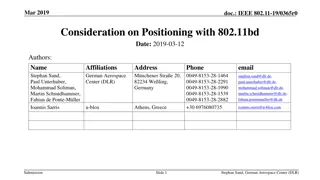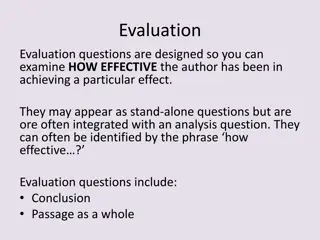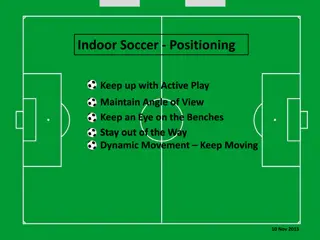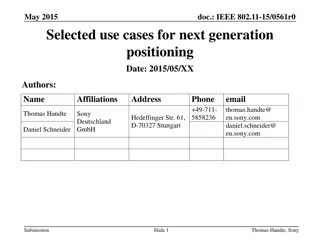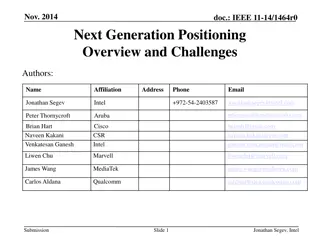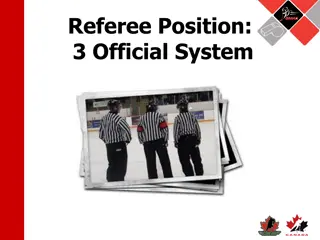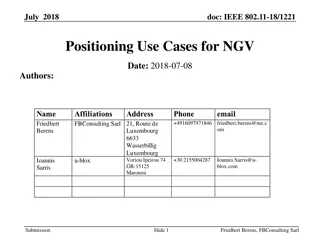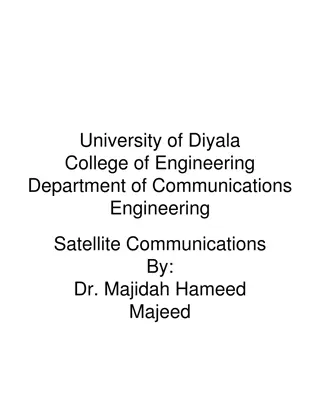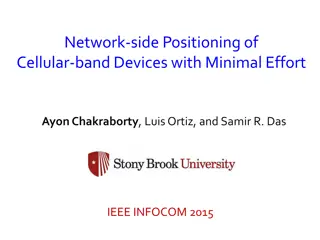Data Collection for AI Positioning: Current Conclusion and Scenarios
The current conclusion on data collection for AI positioning involves triggering data collection from different sources like LMF, UE, RAN, and NWDAF. Two scenarios are discussed regarding the process of collecting training data and how it influences ML model training for AI/ML-based positioning. The detailed end-to-end procedure for data collection is under discussion.
Download Presentation

Please find below an Image/Link to download the presentation.
The content on the website is provided AS IS for your information and personal use only. It may not be sold, licensed, or shared on other websites without obtaining consent from the author.If you encounter any issues during the download, it is possible that the publisher has removed the file from their server.
You are allowed to download the files provided on this website for personal or commercial use, subject to the condition that they are used lawfully. All files are the property of their respective owners.
The content on the website is provided AS IS for your information and personal use only. It may not be sold, licensed, or shared on other websites without obtaining consent from the author.
E N D
Presentation Transcript
Discussion on data collection for AI positioning vivo 1
Current conclusion in the TR 23.700-84 Observation MTLF can train ML model for AI/ML based positioning, MTLF needs to collect training data from the LMF, which will trigger the LMF collects data from UE/RAN/PRU. But the detailed E2E procedure for data collection still needs discussion. LMF can train ML model for AI/ML based positioning, LMF needs to collect training data itself from UE/RAN/PRU. . But the detailed E2E procedure for data collection still needs discussion. 2
Scenario 1: LMF Data collection triggered by NWDAF-1/23 Issue to be resolved: whether NWDAF collects training data from LMF directly or via GMLC/AMF? Option 1: NWDAF collects training data via GMLC and AMF to the LMF, then the LMF re-uses LPP/NRPPa/LCS-SS protocols via CP/UP for data collection from UE/RAN , the LMF notify data to NWDAF directly Evaluation: GMLC RAN AMF LMF UE/PRU NWDAF The AMF can help to select UE list, by checking user consent info on data collection, UE AI positioning capability (i.e. whether UE supports new measurements for AI positioning, ) and other UE LCS privacy info; 0. Determine to collect data for ML model training 1.Data collection subscribe/request (AOI, for AI positioning ) 2.Data collection subscribe/request (AOI, for AI positioning ) 3. LMF selection The AMF can allocate LCS correlation ID for each UE . with the LCS correlation ID, the LMF will trigger the Location service. i.e. using LPP or NRPPa to collect data : 4. UEs selection, and optionally allocating LCS correlation ID for UE 5.Data collection subscribe/request (LCS SUPIs/correlation IDs, for AI positioning) Comply with the existing LCS service logic, the LMF will not initiate UE positioning without AMF triggering, 6. Per each SUPI/ LCS correlation ID, data collection from UE and/or RAN reusing existing LPP/NRPPa/LCS-ss via CP or UP 7. Data collection Notify UE and LMF are fenced from each other, the LMF will not know the UE ID, but only LCS correlation ID from the AMF. Note whether allocating LCS correlation ID for each UE or using SUPI in step 5 no strong preference. 3
Scenario 1: LMF Data collection triggered by NWDAF-2/23 Option 2: NWDAF collects training data from LMF directly, then the LMF re-uses LPP/NRPPa/LCS-ss protocols in CP/UP for data collection from UE/RAN Evaluation: NWDAF may need to select UEs based on user consent info on data collection, UE AI positioning capability and other UE LCS privacy info, these info are usually from AMF; RAN AMF LMF UE/PRU NWDAF 0. Determine to collect data for ML model training LMF will not get LCS correlation ID but only UE ID(e.g. SUPI) from NWDAF. 1. LMF selection 2. UEs selection With UE ID, the LMF collects data from UE/RAN using LPP or NRPPa, or LCS-SS via CP/UP, which brings some impacts breaks the existing LCS service logic: 3.Data collection subscribe/request (UE IDs, for AI positioning ) 4. UEs selection impacts on AMF (to transfer LPP/NRPPa/LCS-SS, together with UE ID not LCS correlation ID) 6. Per each SUPI, data collection from UE and/or RAN using LPP/NRPPa/LCS-ss via CP or UP Impacts on UE (to get LPP/NRPPa /LCS-SS, together with UE ID not LCS correlation ID) 6. Data collection Notify Impacts on LMF (to initiate LPP/NRPPa/LCS-SS message even without LCS correlation ID) Note whether allocating LCS correlation ID for each UE or using SUPI in step 5 no strong preference. Proposal 1: For Scenario 1, option 1 is higher priority. 4
Scenario 1: LMF Data collection triggered by NWDAF-3/3 Option 3: NWDAF collects training data from LMF directly, LMF gets the UE list from AMF, then the LMF re- uses LPP/NRPPa/LCS-SS protocols in CP/UP for data collection from UE/RAN Evaluation: RAN AMF LMF UE/PRU NWDAF AMF needs to select UEs for the LMF, based on user consent info on data collection, UE AI positioning capability and other UE LCS privacy info; 0. Determine to collect data for ML model training 1. LMF selection 3.UE list retrieving (AOI, for AI positioning data colletion ) 2.Data collection subscribe/request (AOI, for AI positioning ) AMF provide SUPI list to LMF, or LCS correlation ID to the LMF 4.UEs selection for data collection ,by checking UE capability, etc. With SUPI or LCS correlation ID, the LMF collects data from UE/RAN using LPP or NRPPa, or LCS-SS via CP/UP. 5.UE list retrieving (SUPI/LCS correlation IDs) 6. Per UE, data collection from UE and/or RAN, enhancing existing LPP, LCS-SS, or NRPPa with UE ID 7. Data collection Notify Note whether allocating LCS correlation ID for each UE or using SUPI in step 5 no strong preference. 5
Observation for scenario 1: Seems more reasonable if AMF selects target UEs by checking UE AI positioning capability, etc. (option 1 and option 3) UE capabilities for AI positioning/data collection are more appropriate to be interpreted as 5GMM capabilities, e.g., LCS-UPP cap and SUPL cap, which are transferred via NAS signaling to AMF and stored in the AMF. Those capacities are different from the capabilities exchanged via LPP messages. Thus, AMF knows such capabilities, not LMF. NWDAF can directly invoke LMF service or via AMF/GMLC, both are workable, TBD. (option 1 and option 3) For each UE, AMF provides SUPI list to LMF, or can allocate LCS correlation IDs, it is TBD. (option 1 and option 3) 6
Scenario 2: LMF data collection based on internal trigger-1/2 Issue to be resolved: without UE ID or LCS correlation ID, how the LMF triggers data collection Option 1: AMF selects UE based on UE AI positioning capability, user consent info, etc. RAN AMF LMF UE/PRU 1. Determine to collect data 2. AIPosData request (AOI, for AI positioning) 3.UE selection 4. AIPosData response(LCS correlation IDs) 5. Per each LCS correlation ID, data collection from UE and/or RAN reusing existing LPP or NRPPa Solution and Evaluation: (this solution keeps consistence with Option 1 for scenario 1 ) The AMF can help to select UE list, by checking user consent info on data collection, UE AI positioning capability (i.e. whether UE supports new measurements for AI positioning, ) and other UE LCS privacy info; The AMF provides SUPI list to the LMF or can allocate LCS correlation ID for each UE . with the SUPI/LCS correlation ID, the LMF will trigger the Location service. i.e. using LPP or NRPPa, LCS-SS via CP/UP to collect data. If using LCS correlation ID: Note whether allocating LCS correlation ID for each UE or using SUPI in step 4 no strong preference. Comply with the existing LCS service logic, the LMF will not initiate UE positioning without AMF triggering, UE and LMF are fenced from each other, the LMF will not know the UE ID, but only LCS correlation ID from the AMF. Proposal 2: For Scenario 2, the above solution is proposed to be adopted. 7
Scenario 2: LMF data collection based on internal trigger-2/2 RAN AMF LMF UDM UE/PRU Option 2: LMF selects UE based on UE AI positioning capability, user consent info, etc. 1. Determine to collect data 2. UE list retrieve (AOI) 3. UE list provision SUPI list in AOI 4.UE selection based on UE capability etc. 5. Per SUPI , data collection from UE and/or RAN, using LPP /NRPPa/LCS-SS via CP or UP Solution and Evaluation: The LMF needs to know whether UE supports UE AI positioning capability (i.e. whether UE supports new measurements for AI positioning,), which is more like the functionality of AMF With SUPI, the LMF needs to collect data from UE/RAN using LPP or NRPPa, or LCS-SS via CP/UP, which brings some impacts: impacts on AMF (to transfer LPP/NRPPa/LCS-SS, together with UE ID not LCS correlation ID) Note whether allocating LCS correlation ID for each UE or using SUPI in step 4 no strong preference. Impacts on UE (to get LPP/NRPPa /LCS-SS, together with UE ID not LCS correlation ID) Impacts on LMF (to initiate LPP/NRPPa/LCS-SS message even without LCS correlation ID) 8
Observation for scenario 2: Seems more reasonable if AMF selects target UEs by checking UE AI positioning capability(i.e. whether UE supports new measurements for AI positioning), etc. UE capabilities for AI positioning/data collection are more appropriate to be interpreted as 5GMM capabilities, e.g., LCS-UPP cap and SUPL cap, which are transferred via NAS signaling to AMF and stored in the AMF. Those capacities are different from the capabilities exchanged via LPP messages. Thus, AMF knows such capabilities, not LMF. For each UE, AMF provides SUPI to LMF, or can allocate LCS correlation ID, it is TBD. 9





